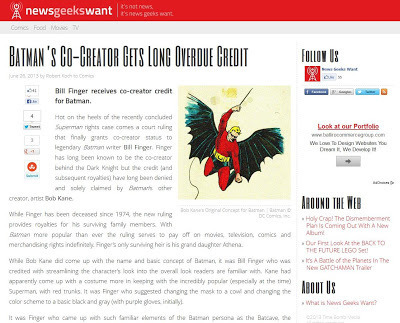Marc Tyler Nobleman's Blog, page 104
July 2, 2013
An original Boy of Steel gives love to Bill Finger
Phil Yeh became my friend after an interview I conducted with him in 2008. I conducted an interview with him because he was instrumental in bringing attention to the plight of Jerry Siegel and Joe Shuster in the 1970s.
And now he’s done something for another undercredited Golden Age great, our very own Bill Finger:
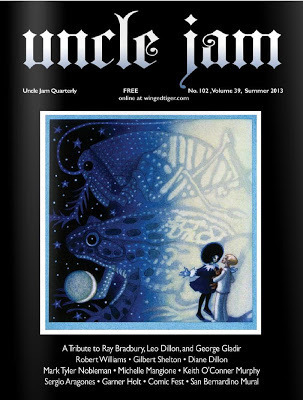 Uncle Jam #102 (summer 2013)
Uncle Jam #102 (summer 2013)
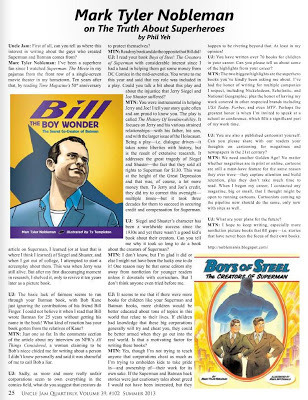 He profusely apologized for misspelling my first name.I am especially forgiving to anyone who devotes ink to Bill Finger.
He profusely apologized for misspelling my first name.I am especially forgiving to anyone who devotes ink to Bill Finger.
Thank you, Phil, for fighting the noble fight on behalf of comics creators for going on 40 years.
And now he’s done something for another undercredited Golden Age great, our very own Bill Finger:
 Uncle Jam #102 (summer 2013)
Uncle Jam #102 (summer 2013)  He profusely apologized for misspelling my first name.I am especially forgiving to anyone who devotes ink to Bill Finger.
He profusely apologized for misspelling my first name.I am especially forgiving to anyone who devotes ink to Bill Finger. Thank you, Phil, for fighting the noble fight on behalf of comics creators for going on 40 years.
Published on July 02, 2013 04:00
July 1, 2013
BBYO International Leadership Training Conference (ILTC)
10 p.m.
That's approximately what time I began my hourlong 6/29/13 talk at ILTC, an annual summer event held by the B'nai B'rith Youth Organization (of which I was a proud member) in Pennsylvania.
The attendees are Jewish teens (this year, about 230) from around the world who want to strengthen their own leadership skills—and therefore their regions. In fact, the theme this year was "Strength to Strength," so it was appropriate that I came bearing stories not only of superheroes but also their (Jewish) creators (who were strong in non-physical ways).
It was the latest I have ever started a presentation. But teens—especially teens in summer, and especially teens in summer away from home—are immortal. Time is an endless river. Night is an adrenaline boost.
While in BBYO, I attended two international conventions, but not ILTC. Funny that I finally made it there, at age 41. Both of my ICs were at a camp in Starlight, Pennsylvania...and it turns out that camp was right next to this one, in Lake Como, PA. Or maybe Starlight is now Lake Como? I wasn't clear.
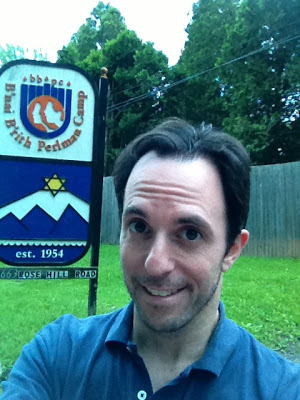 arriving around 8:30 p.m.
arriving around 8:30 p.m.
Beyond the most obvious, like cell phones, I observed several fixtures that weren't present when I was in BBYO, including Purell dispensers and dangling name badges for everyone. The culture has gotten more protective against both germs and strangers. Though all wore a badge, I find only one visible in this photo; you'll have to squint:
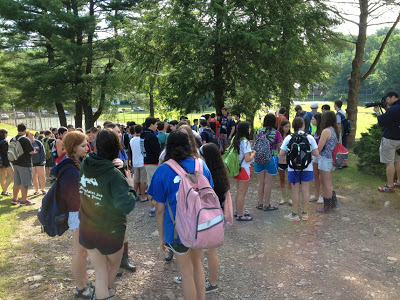
And I came across a familiar face:
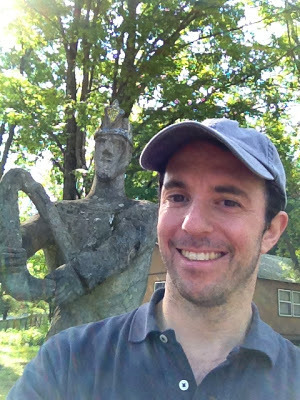 me on 6/30/13
me on 6/30/13
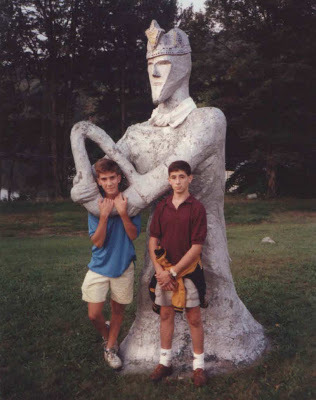 two friends around 8/22/89
two friends around 8/22/89
I gave the talk on the kind of stage I spoke/played on numerous times as a BBYO member. I don't use notes but do have my PowerPoint slides printed out so I don't botch the order of any of the surprise reveals. As you can see, I improvised a podium:
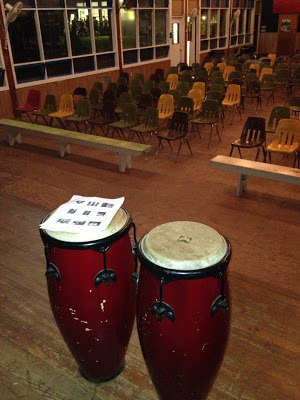
During the closing Q&A, the first question was about as humbling as it gets: "Can you come speak to my region?"
My digs for the night:
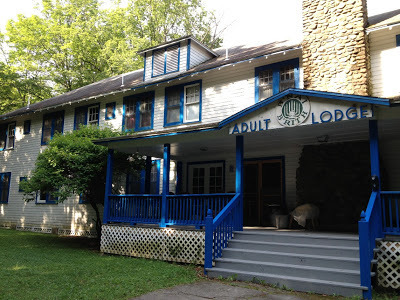
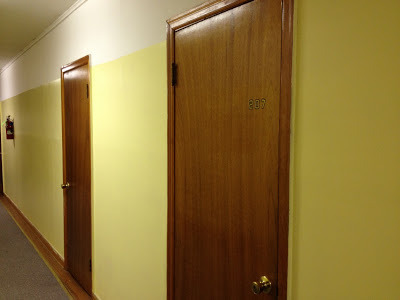
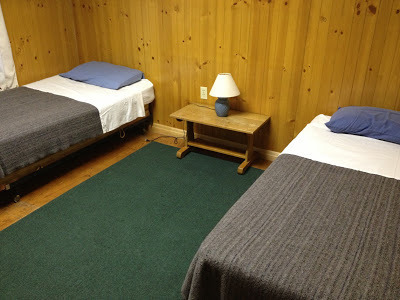
The lodge included a bookshop, though it looks more like a library:
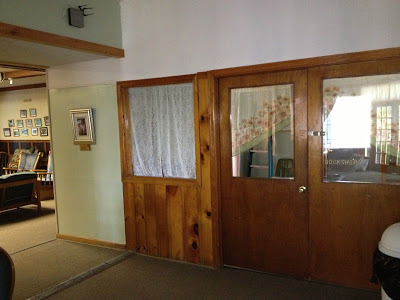
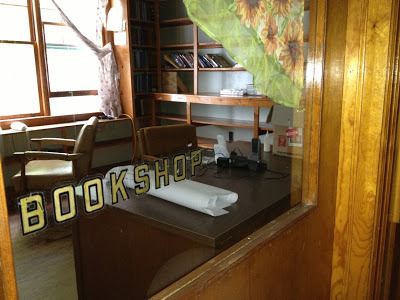
And there was this great old photo whose caption was even greater:
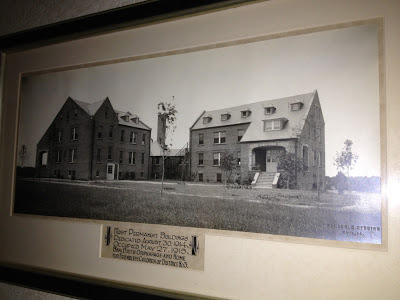
Thank you again, BBYO, for inviting me back into the fold for a day. It was, and will always be, my honor.
That's approximately what time I began my hourlong 6/29/13 talk at ILTC, an annual summer event held by the B'nai B'rith Youth Organization (of which I was a proud member) in Pennsylvania.
The attendees are Jewish teens (this year, about 230) from around the world who want to strengthen their own leadership skills—and therefore their regions. In fact, the theme this year was "Strength to Strength," so it was appropriate that I came bearing stories not only of superheroes but also their (Jewish) creators (who were strong in non-physical ways).
It was the latest I have ever started a presentation. But teens—especially teens in summer, and especially teens in summer away from home—are immortal. Time is an endless river. Night is an adrenaline boost.
While in BBYO, I attended two international conventions, but not ILTC. Funny that I finally made it there, at age 41. Both of my ICs were at a camp in Starlight, Pennsylvania...and it turns out that camp was right next to this one, in Lake Como, PA. Or maybe Starlight is now Lake Como? I wasn't clear.
 arriving around 8:30 p.m.
arriving around 8:30 p.m.Beyond the most obvious, like cell phones, I observed several fixtures that weren't present when I was in BBYO, including Purell dispensers and dangling name badges for everyone. The culture has gotten more protective against both germs and strangers. Though all wore a badge, I find only one visible in this photo; you'll have to squint:

And I came across a familiar face:
 me on 6/30/13
me on 6/30/13 two friends around 8/22/89
two friends around 8/22/89I gave the talk on the kind of stage I spoke/played on numerous times as a BBYO member. I don't use notes but do have my PowerPoint slides printed out so I don't botch the order of any of the surprise reveals. As you can see, I improvised a podium:

During the closing Q&A, the first question was about as humbling as it gets: "Can you come speak to my region?"
My digs for the night:



The lodge included a bookshop, though it looks more like a library:


And there was this great old photo whose caption was even greater:

Thank you again, BBYO, for inviting me back into the fold for a day. It was, and will always be, my honor.
Published on July 01, 2013 04:00
June 30, 2013
Back to BBYO
On 4/20/13, I spoke at the spring convention of the Connecticut Valley Region of the B’nai B’rith Youth Organization (BBYO).
I used to do this all the time…but not as an author. I was an avid member of CVR BBYO during high school, and at almost every event took to the stage as either a leader or a performer (term used loosely).
So it was an immense honor—and more than a little sentimental—to return to a convention and to speak there. Teens are taller now than when I was one.
In my hourlong presentation I talked about my career, but what felt most special was giving them a glimpse of my formative time in BBYO. Though they’d never heard of me as an author, they were keen to hear the experiences of one of their own; the organization fosters such a fervent bond among young people that anyone who has gone through it is of immediate interest to anyone currently in it.
I started my mini-retrospective by mentioning the five guys who were my best friends back then and I showed the first known photo taken of the six of us:
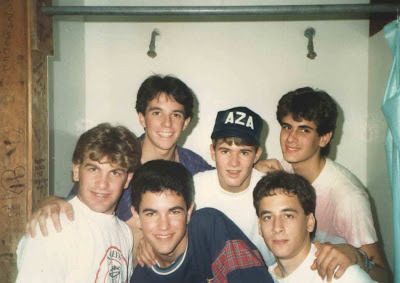 Kevin, me, Seth (blue shirt with red tartan), Matt (in hat), Darren (with bracelets), Mike; yes, we were standing in camp cabin shower
Kevin, me, Seth (blue shirt with red tartan), Matt (in hat), Darren (with bracelets), Mike; yes, we were standing in camp cabin shower
We were called the Ruach 6—“Ruach” was the name of our chapter (in Hebrew it means “spirit”). I cycled through other BBYO moments that had an impact on me. I concluded by re-showing that first group photo…then revealing that those five guys I was best friends with in 1988 are still my best friends today:
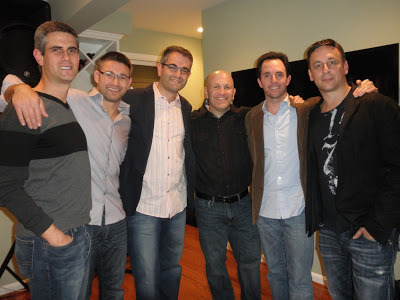
The room rippled with the warmth of human connection and jittery excitement for the future.
The kids stopped to digest the possibility that they were in the presence of friends for life.
But I’m sure many of them already knew that.
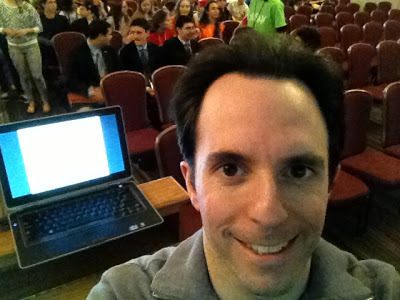 selfie before my talk
selfie before my talk
I used to do this all the time…but not as an author. I was an avid member of CVR BBYO during high school, and at almost every event took to the stage as either a leader or a performer (term used loosely).
So it was an immense honor—and more than a little sentimental—to return to a convention and to speak there. Teens are taller now than when I was one.
In my hourlong presentation I talked about my career, but what felt most special was giving them a glimpse of my formative time in BBYO. Though they’d never heard of me as an author, they were keen to hear the experiences of one of their own; the organization fosters such a fervent bond among young people that anyone who has gone through it is of immediate interest to anyone currently in it.
I started my mini-retrospective by mentioning the five guys who were my best friends back then and I showed the first known photo taken of the six of us:
 Kevin, me, Seth (blue shirt with red tartan), Matt (in hat), Darren (with bracelets), Mike; yes, we were standing in camp cabin shower
Kevin, me, Seth (blue shirt with red tartan), Matt (in hat), Darren (with bracelets), Mike; yes, we were standing in camp cabin showerWe were called the Ruach 6—“Ruach” was the name of our chapter (in Hebrew it means “spirit”). I cycled through other BBYO moments that had an impact on me. I concluded by re-showing that first group photo…then revealing that those five guys I was best friends with in 1988 are still my best friends today:

The room rippled with the warmth of human connection and jittery excitement for the future.
The kids stopped to digest the possibility that they were in the presence of friends for life.
But I’m sure many of them already knew that.
 selfie before my talk
selfie before my talk
Published on June 30, 2013 04:00
June 29, 2013
The first person to play Bill Finger?
On 6/5/13, I went to a Maryland wax museum, but not one in the traditional sense. The wax figures were really human beings—third grade human beings doing a class project.
And one, I’m heartened to report, chose to be Bill Finger, uncredited co-creator and original writer of Batman.
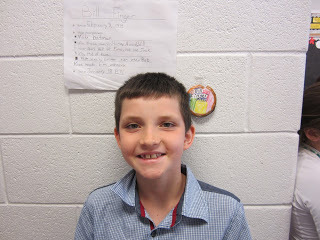
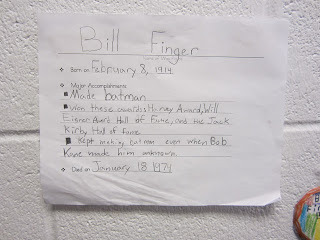
In fact, he may be the first person ever to play Bill Finger. But there will be others. Even just a year ago, a young person choosing Bill for such a project was unthinkable.
As this young man delivered his short, memorized monologue as Bill, dressed in a blue button-down as Bill often did, I unabashedly teared up.
This is why I wrote Bill the Boy Wonder: The Secret Co-Creator of Batman.
And this is the second time I’ve heard of a young person portraying a superhero creator I’ve written about.
If you know of any other kids who have role-played Bill, Jerry Siegel, or Joe Shuster, please let me know.
And one, I’m heartened to report, chose to be Bill Finger, uncredited co-creator and original writer of Batman.


In fact, he may be the first person ever to play Bill Finger. But there will be others. Even just a year ago, a young person choosing Bill for such a project was unthinkable.
As this young man delivered his short, memorized monologue as Bill, dressed in a blue button-down as Bill often did, I unabashedly teared up.
This is why I wrote Bill the Boy Wonder: The Secret Co-Creator of Batman.
And this is the second time I’ve heard of a young person portraying a superhero creator I’ve written about.
If you know of any other kids who have role-played Bill, Jerry Siegel, or Joe Shuster, please let me know.
Published on June 29, 2013 04:00
June 28, 2013
An Elseworlds Batman tale...or a prediction for the future?
Published on June 28, 2013 17:15
Children’s Literature Conference at Shenandoah University in Virginia

On 6/28/13, I was thrilled to make my second consecutive appearance at the Children’s Literature Conference at Shenandoah University in Virginia; this was the 28th annual.
It is one of my favorite conferences.
My schedule this year:
1.5-hour writing workshop with middle schoolerspresentation to educatorstwo breakout Q&A sessions with educatorsbook signingturkey and cheese croissant sandwich
The hallmarks from last year all made welcome (except for the heat) returns.
Star-studded roster:
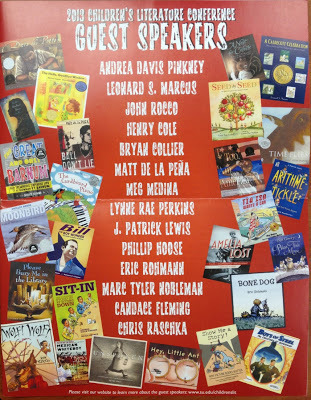
Beautiful hand-painted banner (all by the same student!) representing every author:
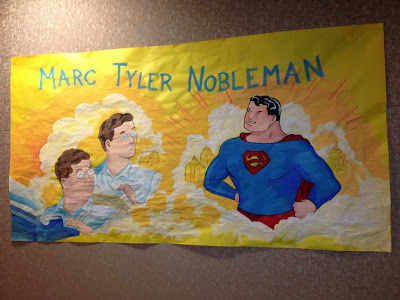
A mug with our names on it:
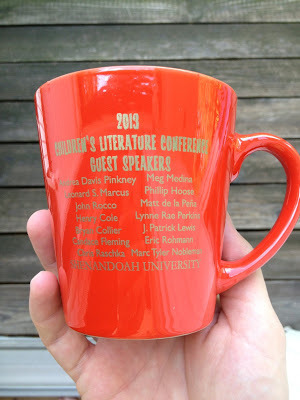
Extreme bookselling:
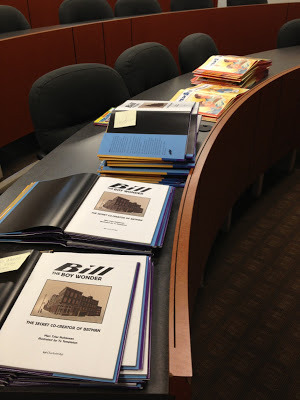
Bathroom signs featuring author and book quotations:
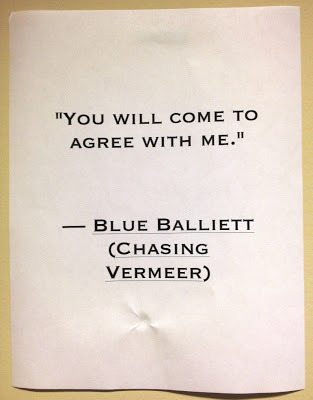
At first I read this as "You will agree to come with me," which is as lovely a description as any for a person surrendering to a good book.
Thank you again to Karen Huff, my kind right-hand woman Becky, and the rest of the crew for making this a must-attend conference. And thank you to the audiences, who were more than receptive and engaged throughout. I look forward to visiting as many of your schools as I can...and I look forward to (hopefully) seeing you at the 29th.
Published on June 28, 2013 16:37
June 27, 2013
Good people can always do more
On Comic Book Resources, Greg Hatcher took up the Bill Finger cause in his 5/18/13 column, with focus on Finger's role in the creation of the Clock King. Bill co-wrote the two-part episode of the 1966 Batman TV show that featured the villain.
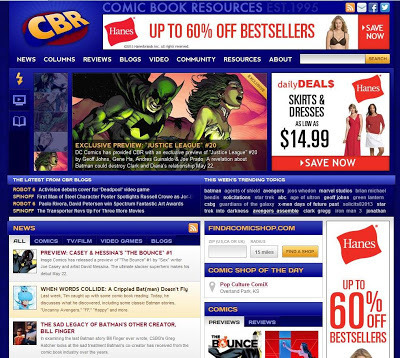
The comments section was a passion pit (which I also jumped into), and these two in particular had an impact on me:
People coming to the defense of people coming to the defense.
Justice has no expiration date.

The comments section was a passion pit (which I also jumped into), and these two in particular had an impact on me:
Herb Finn
May 20, 2013 at 5:54 pm
Marc is a good researcher, writer, and blogger (and a decent cartoonist, too!) but there is NO WAY he will ever get DC to change or add Bill Finger to the “created by” byline on Batman. There are too many legal issues – and DC finally got resolution over the Superman issues (notice new bylines on the comics) and DO NOT want to deal with something on that scale that will affect millions.
I think Marc should let this rest. DC is paying royalties for reprints of Bill’s stories to Bill’s granddaughter (after years of being misdirected to a former “friend” of her father), which is all they can do.
joshschr
May 20, 2013 at 6:38 pm
> I think Marc should let this rest. DC is paying royalties for reprints of Bill’s stories to Bill’s granddaughter (after years of being misdirected to a former “friend” of her father), which is all they can do.
No. Good people can always do more.
People coming to the defense of people coming to the defense.
Justice has no expiration date.
Published on June 27, 2013 04:00
June 26, 2013
Bill Finger at the 92nd Street Y

On 5/15/13, I had the pleasure of returning to the 92nd Street Y in New York to speak about a Great Event that happened not far from there: the creation of Batman.
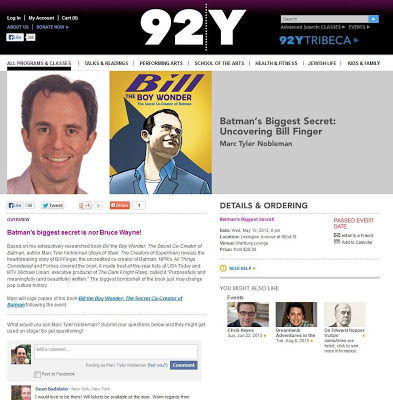
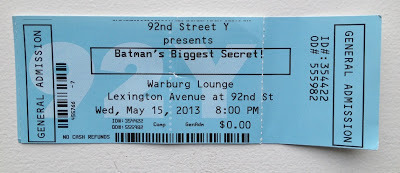 This was a comp ticket; as shown in the previous image, people actually had to part with $29 to hear me, which I thought would mean (far) fewer than 29 would show up.
This was a comp ticket; as shown in the previous image, people actually had to part with $29 to hear me, which I thought would mean (far) fewer than 29 would show up.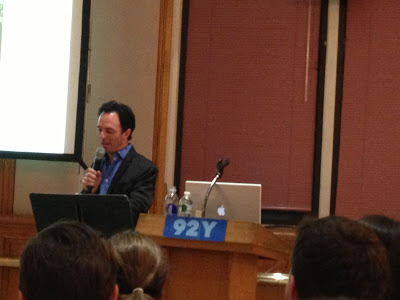
The venue alone was an honor, as was the fact that people I care about came to listen, including a gaggle of college friends:
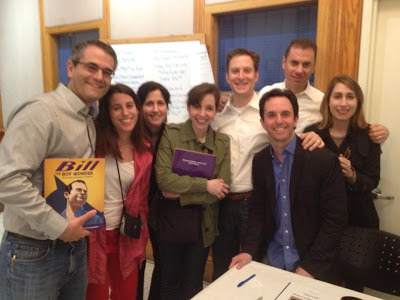
One of the three people to whom the book is dedicated also humbled me with his attendance: Charles Sinclair, Bill’s longtime friend and sometime writing partner.
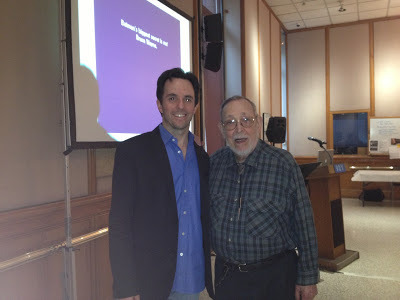
Like the last time I spoke at the Y (2009), I took a photo of the room before I started:
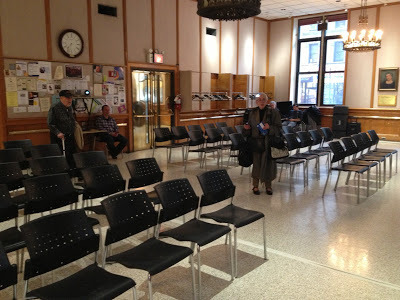
But unlike the last time, I forgot to take one of the room once it’d filled in, which was the point.
The event generated some wonderful coverage.
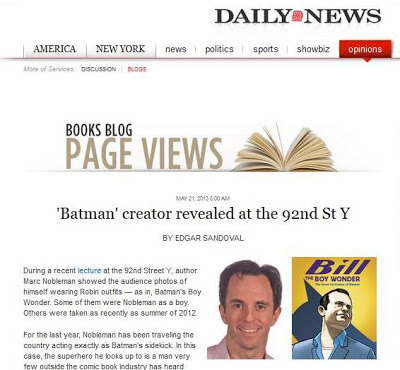 New York Daily News
New York Daily News Newsarama
NewsaramaAnd the coverage generated some wonderful coverage.
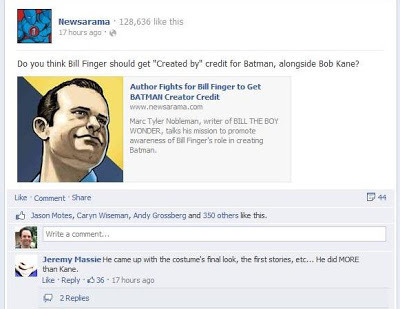
More than 350 likes and almost 50 shares
for the Facebook link to the Newsarama article.
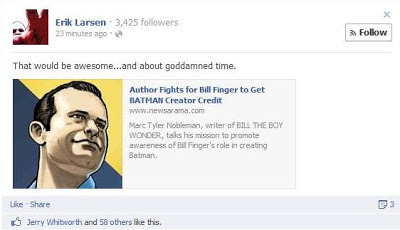 Savage Dragon creator Erik Larsen weighed in on Facebook.
Savage Dragon creator Erik Larsen weighed in on Facebook. Thank you again to Sidney Burgos for hosting me. Hope to speak under your roof again.
Published on June 26, 2013 04:00
June 25, 2013
Jewish Book Council Network 2013
For the second year in a row, I’m thrilled to be on the author roster of the Jewish Book Council Network. The New York Times referred to the annual JBC Network Meet the Author event as “a combination of The Gong Show and speed-dating.”

Last year I got to talk about Batman. This year Superman. And as if on cue, upon arriving in New York City on 6/2/13 to give my two-minute pitch to a roomful of programming directors from 100 Jewish institutions across North America, I see and snap this:

The scene juxtaposes two American icons forged in the same decade: the Empire State Building (completed 1931) and the Man of Steel (conceived 1933, debuted 1938).
Here is the room in which the authors (numbering around 50) presented back-to-back, and some of the people to whom we presented:
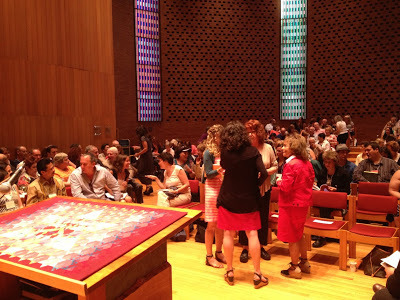
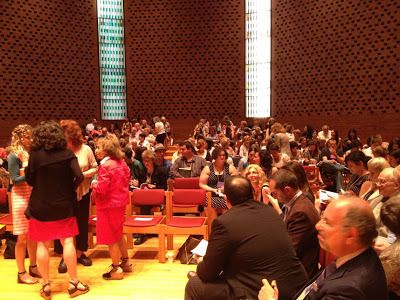
I look forward to coming to as many of your communities as possible over the next year.
Here was my two-minute pitch:

Last year I got to talk about Batman. This year Superman. And as if on cue, upon arriving in New York City on 6/2/13 to give my two-minute pitch to a roomful of programming directors from 100 Jewish institutions across North America, I see and snap this:

The scene juxtaposes two American icons forged in the same decade: the Empire State Building (completed 1931) and the Man of Steel (conceived 1933, debuted 1938).
Here is the room in which the authors (numbering around 50) presented back-to-back, and some of the people to whom we presented:


I look forward to coming to as many of your communities as possible over the next year.
Here was my two-minute pitch:
During dangerous times, a baby boy is born. For his own good, his parents give him up, sending him off in a vessel. Another family finds him and raises him as their own, without knowing where he came from. Eventually, he learns his history…and his destiny…and becomes a savior.
Sound familiar?
Yes, Moses…but also Superman. As his planet is about to explode, his parents launch him to safety in a rocket. He lands on Earth an infant, a Kansas couple adopts him, and he grows up to be the world’s greatest superhero.
He was also the world’s first, created during the Depression by two Jewish teens, writer Jerry Siegel and artist Joe Shuster. They were geeks before the word existed.
Was the Moses parallel intentional? Did Hitler himself call Superman a Jew and ban his comics from Nazi Germany? What is the Jewish connection to Superman’s Kryptonian name? And why did Shabbat prevent Joe from drawing Superman? No, not the obvious reason!
Boys of Steel: The Creators of Superman answers these questions, debunks myths, and solves mysteries. It’s an all-ages book and the first standalone bio on the men of Cleveland behind the Man of Steel. It’s both inspirational and heartbreaking—even to people who couldn’t care less about superheroes. It reveals a discovery that made the front page of USA Today. It in part led to my TED talk. And it’s an Association of Jewish Libraries Notable Book of Jewish Content, the revised edition of which is out this year for the 75th anniversary of Superman.
I’ve been invited to speak to standing-room-only adult audiences at Jewish institutions nationwide, and I’m thrilled to be on the JBC Network for the second year in a row. Let’s celebrate this icon together, along with truth, justice, and the Jewish-American way.
Published on June 25, 2013 04:00
June 24, 2013
“The Bloodhound Gang” (“3-2-1 Contact”) cast interviews, 4 of 4
Part 1.
Part 2.
Part 3.
“The Bloodhound Gang” was a series of short, live-action mysteries that may have been the most popular segment of the 1980s PBS science show 3-2-1 Contact.
When was the last time you watched an episode—and how did it hold up?
Nan: I think about a year ago. “The Thing in the Trunk” is on YouTube. It holds up great. The show was so well done.
Seth: Most can be found on YouTube. I got a kick out of the humor I still see in the episodes, but cringe at my acting.
Glenn: Not in a while, but when I do, it always brings back wonderful memories. The time it was shot is very present in each episode…the cars, the wardrobe. It’s a trip to watch. New York was a different place in the late ‘70s.
If you are/were married, what was your future spouse/partner’s reaction when s/he learned you were in this series?
Nan: My husband gets a real kick out of it. He wasn’t familiar with it when we first met. He’s from Minnesota. Not sure if it even played out there. But when he saw them, he loved it.
Glenn: My current partner has never seen it. One of these days, I must force him to watch. He might make me sit through his bar mitzvah, though.
What do your kids think of the series?
Nan: My older daughter is 30, my son is 23, and my younger daughter is 18. They all think it’s a hoot. None of them were born when I did the series. I think they’re proud of their mom.
What did you think when you heard I wanted to interview you?
Nan: I was excited. That was a very special time in my life. As I mentioned, when people do recognize me in public, I see their faces as they were when they were 8, 9, 10 years old. Some have even said it’s why they got into science or became a teacher, etc.
Seth: I know your work and thought you would do a fair and admirable job of telling this little story.
Glenn: I thought, “How cool.”
Has anyone else ever interviewed about this? If so, who, when, and for what publication(s)?
Nan: Honestly, I don’t recall. For it to have been such a popular show, we received very little personal publicity. A magazine spin-off 3-2-1 Contact did include a segment called “The Bloodhound Gang” with characters that resembled us in the cast. I would love for it to make a comeback somehow as science and math are two subjects getting a real big push for our kids to really excel in.
Seth: Nope.
Glenn: I have never been interviewed like this about that show. It has been brought up every so often but I am touched that you want to talk about this, Marc. Right on. It was a big part of my childhood, too.
Have you appeared at any fan conventions to sign autographs?
Nan: I have not.
Seth: Nope.
Would you?
Nan: I certainly would. One thing my fans say when they see me is I haven’t really changed much.
Seth: It would be far too weird for me to do, so far removed from the show.
Did you stay in touch with anyone from the series? If so, how often?
Nan: Just Marcelino for that brief time and then, thanks to LinkedIn (or Facebook—can’t remember) I heard from Seth. What a wonderful surprise. So we are in touch now and I am very happy about that.
Seth: Just Nan.
Glenn: I’m sorry to say I haven’t. Maybe through this interview you can reunite us…
How do you look back on the experience?
Nan: Very fondly. It was at the beginning of my career. I always wanted to be an actress—why, I don’t know. But I just knew that I could and that I would. It was something beyond my control. I felt like that was where I was meant to be.
Glenn: With warm, happy, loving thoughts and memories. When you do a show like that, it’s not just what appears on the screen that remains in my heart but rather all the people. Great, talented people on that show.
Anything you’d like to add?
Nan: I would like to mention Linda Marmelstein. She was the producer and a very kind and supportive person. She gave me wonderful recommendations. She was diagnosed with cervical cancer while we were shooting our last year. She still came to the set every day. I remember her very fondly for her gentleness and perseverance in times of adversity.
Seth: I stayed in contact with the production company, Daniel Wilson Productions, for years afterwards. Linda Marmelstein, the executive producer, was a wonderful friend for a number of years. We kept in touch through my high school years, and she kept feeding my interest in moving behind the camera. She wrote me a recommendation for NYU’s film and TV program. While at college, Linda lost a silent, stoic battle with cancer, and I lost a friend. DWP continued to support my education, lending me an editing suite for several months so I could edit my senior thesis film. Daniel and Linda were wonderful people, and I will never forget their support.
Most of what you see on the Apple 2 computer in our “office” was actually my programming. There was a BASIC emulator included that allowed me to write programs for the show. I learned some computer language in elementary school—they had a program for children who showed advanced abilities in math and science, and the classroom included a TRS-80 Tandy Radio Shack computer. When we showed up at the “office” for the last week of shooting (actually a room in a fantastic Victorian mansion in the low 70’s on Central Park West), the director was trying to block the scene in a way to hide the computer screen. Seems that there was nothing prepared to go on the screen for that scene. I spent five minutes and wrote a quick program that followed the script, and suddenly the computer was able to play. So I took it upon myself to do all the programming for both seasons. I think that was the highlight of my computer career, but I still get a kick out of the crew’s reaction—“this seventh-grader is programming a computer!” I was typecast.
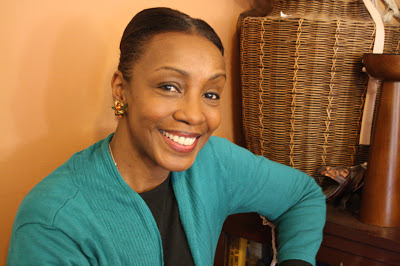 Nan
Nan
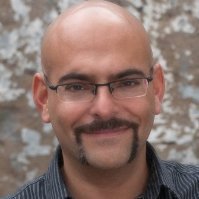 Seth
Seth
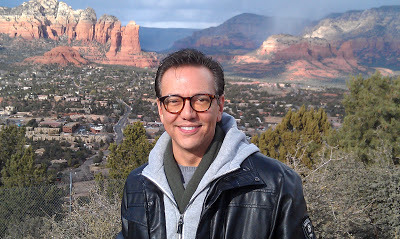 Glenn
Glenn
Part 2.
Part 3.
“The Bloodhound Gang” was a series of short, live-action mysteries that may have been the most popular segment of the 1980s PBS science show 3-2-1 Contact.
When was the last time you watched an episode—and how did it hold up?
Nan: I think about a year ago. “The Thing in the Trunk” is on YouTube. It holds up great. The show was so well done.
Seth: Most can be found on YouTube. I got a kick out of the humor I still see in the episodes, but cringe at my acting.
Glenn: Not in a while, but when I do, it always brings back wonderful memories. The time it was shot is very present in each episode…the cars, the wardrobe. It’s a trip to watch. New York was a different place in the late ‘70s.
If you are/were married, what was your future spouse/partner’s reaction when s/he learned you were in this series?
Nan: My husband gets a real kick out of it. He wasn’t familiar with it when we first met. He’s from Minnesota. Not sure if it even played out there. But when he saw them, he loved it.
Glenn: My current partner has never seen it. One of these days, I must force him to watch. He might make me sit through his bar mitzvah, though.
What do your kids think of the series?
Nan: My older daughter is 30, my son is 23, and my younger daughter is 18. They all think it’s a hoot. None of them were born when I did the series. I think they’re proud of their mom.
What did you think when you heard I wanted to interview you?
Nan: I was excited. That was a very special time in my life. As I mentioned, when people do recognize me in public, I see their faces as they were when they were 8, 9, 10 years old. Some have even said it’s why they got into science or became a teacher, etc.
Seth: I know your work and thought you would do a fair and admirable job of telling this little story.
Glenn: I thought, “How cool.”
Has anyone else ever interviewed about this? If so, who, when, and for what publication(s)?
Nan: Honestly, I don’t recall. For it to have been such a popular show, we received very little personal publicity. A magazine spin-off 3-2-1 Contact did include a segment called “The Bloodhound Gang” with characters that resembled us in the cast. I would love for it to make a comeback somehow as science and math are two subjects getting a real big push for our kids to really excel in.
Seth: Nope.
Glenn: I have never been interviewed like this about that show. It has been brought up every so often but I am touched that you want to talk about this, Marc. Right on. It was a big part of my childhood, too.
Have you appeared at any fan conventions to sign autographs?
Nan: I have not.
Seth: Nope.
Would you?
Nan: I certainly would. One thing my fans say when they see me is I haven’t really changed much.
Seth: It would be far too weird for me to do, so far removed from the show.
Did you stay in touch with anyone from the series? If so, how often?
Nan: Just Marcelino for that brief time and then, thanks to LinkedIn (or Facebook—can’t remember) I heard from Seth. What a wonderful surprise. So we are in touch now and I am very happy about that.
Seth: Just Nan.
Glenn: I’m sorry to say I haven’t. Maybe through this interview you can reunite us…
How do you look back on the experience?
Nan: Very fondly. It was at the beginning of my career. I always wanted to be an actress—why, I don’t know. But I just knew that I could and that I would. It was something beyond my control. I felt like that was where I was meant to be.
Glenn: With warm, happy, loving thoughts and memories. When you do a show like that, it’s not just what appears on the screen that remains in my heart but rather all the people. Great, talented people on that show.
Anything you’d like to add?
Nan: I would like to mention Linda Marmelstein. She was the producer and a very kind and supportive person. She gave me wonderful recommendations. She was diagnosed with cervical cancer while we were shooting our last year. She still came to the set every day. I remember her very fondly for her gentleness and perseverance in times of adversity.
Seth: I stayed in contact with the production company, Daniel Wilson Productions, for years afterwards. Linda Marmelstein, the executive producer, was a wonderful friend for a number of years. We kept in touch through my high school years, and she kept feeding my interest in moving behind the camera. She wrote me a recommendation for NYU’s film and TV program. While at college, Linda lost a silent, stoic battle with cancer, and I lost a friend. DWP continued to support my education, lending me an editing suite for several months so I could edit my senior thesis film. Daniel and Linda were wonderful people, and I will never forget their support.
Most of what you see on the Apple 2 computer in our “office” was actually my programming. There was a BASIC emulator included that allowed me to write programs for the show. I learned some computer language in elementary school—they had a program for children who showed advanced abilities in math and science, and the classroom included a TRS-80 Tandy Radio Shack computer. When we showed up at the “office” for the last week of shooting (actually a room in a fantastic Victorian mansion in the low 70’s on Central Park West), the director was trying to block the scene in a way to hide the computer screen. Seems that there was nothing prepared to go on the screen for that scene. I spent five minutes and wrote a quick program that followed the script, and suddenly the computer was able to play. So I took it upon myself to do all the programming for both seasons. I think that was the highlight of my computer career, but I still get a kick out of the crew’s reaction—“this seventh-grader is programming a computer!” I was typecast.
 Nan
Nan Seth
Seth Glenn
Glenn
Published on June 24, 2013 04:00

